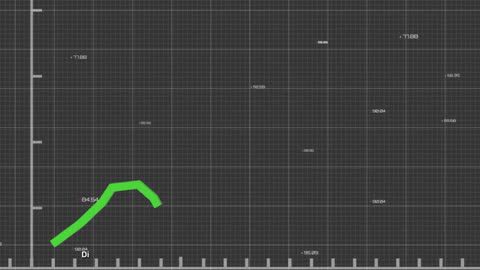What is the stochastic oscillator?
A stochastic oscillator is a momentum indicator that compares a particular closing price of a security to a range of its prices over a specific period. The sensitivity of the oscillator to market movements can be reduced by adjusting that time period or by taking a moving average of the result. It is used to generate overbought and oversold trading signals, utilising a 0-100 bounded range of values.
How Stochastic Oscillator works?
The stochastic oscillator compares a specific closing price of an asset with a wide range of high and low prices over a given period. As a general rule, the stochastic oscillator is calculated using a 14-day time period as the standard. However, the time period can be adjusted to suit specific needs. The value of the stochastic indicator for any particular time period is always between 0 and 100.
Oscillator history
Dr. George Lane developed the Stochastic Oscillator in the late 1950s for use in technical analysis of securities. Lane, a financial analyst, was one of the first researchers to publish research papers on the use of stochastics. He believed the indicator could be profitably used in conjunction with Fibonacci retracement cycles or with Elliott Wave theory.
Lane noted that the Stochastic Oscillator indicates the momentum of a security’s price movement. It is not a trend indicator for price, unlike a moving average indicator. The oscillator compares the position of a security’s closing price relative to the high and low (max and min) of its price range during a specified period of time. In addition to measuring the strength of price movement, the oscillator can also be used to predict market reversal turning points.
Stochastic oscillator formula
%K = (C - L14) / (H14 - L14) * 100
where:
- C = The most recent closing price
- L14 = The lowest price traded of the 14 previous trading sessions
- H14 = The highest price traded during the same1 14-day period
- %K = The current value of the stochastic indicator
Note: %K is sometimes referred to as the fast stochastic indicator. The "slow" stochastic indicator is taken as %D, which is a 3-period moving average of %K.
The underlying theory for this indicator is that in an uptrending market, prices will close near the high, and in a downtrending market, prices close near the low. Trading signals are generated when the %K crosses through a three-period moving average, known as the %D.
The difference between the slow and fast Stochastic Oscillator lies in the Slow %K, which incorporates a %K smoothing period of 3 to control its internal smoothing. Setting the smoothing period to 1 is equivalent to plotting the Fast Stochastic Oscillator.
Example of Stochastic Oscillator
Let's illustrate how the Stochastic Oscillator can be applied with a hypothetical example:
Scenario: Imagine you are a trader interested in a stock listed on the National Stock Exchange (NSE) of India. You want to use the Stochastic Oscillator to assess potential trading opportunities.
Stock: ABC Ltd (fictional stock)
Timeframe: Daily closing prices over the past 14 trading days
Stochastic Oscillator Parameters:
- %K Period: 14
- %D Period: 3 (3-day moving average of %K)
Example Calculation
1. Data Collection: Gather the closing prices for ABC Ltd over the past 14 trading days.
2. Calculate %K: Start by calculating the highest high and lowest low over the past 14 days. In this case let’s consider the following:
- Highest High (HH) = ₹155
- Lowest Low (LL) = ₹120
Calculate the %K for Day 14 using the formula:
- %K (Day 14) = [(Closing Price - LL) / (HH - LL)] * 100
- %K (Day 14) = [₹155 - ₹120 / ₹155 - ₹120] * 100
- %K (Day 14) ≈ 78.26
3. Calculate %D: Now, calculate the 3-day moving average of %K, starting from Day 14:
- %D (Day 14) = (78.26 + %K (Day 13) + %K (Day 12)) / 3
- %D (Day 14) ≈ (78.26 + 82.76 + 86.67) / 3
- %D (Day 14) ≈ 82.90
Interpretation
- %K on Day 14 is approximately 78.26.
- %D on Day 14 is approximately 82.90.
Now, you would use these values to interpret potential trading signals:
- %K below 20 could indicate an oversold condition (bullish potential).
- %K above 80 could indicate an overbought condition (bearish potential).
In this example, with %K at 78.26 and %D at 82.90, you might consider monitoring the stock closely for potential trading opportunities, keeping an eye out for any crossovers or divergences to confirm your decision within the context of other market analysis.
Relative strength index (RSI) vs. Stochastic oscillator
Here are main simililarities and differences between relative strength index (RSI) vs. stochastic oscillator
Similarities
Feature
|
Stochastic Oscillator
|
RSI
|
Purpose
|
Measures momentum and identifies overbought/oversold conditions
|
Measures momentum and identifies overbought/oversold conditions
|
Scale
|
0 to 100
|
0 to 100
|
Differences
Feature
|
Stochastic Oscillator
|
RSI
|
Calculation
|
Compares closing price to price range over a specific period
|
Calculates average of price gains and losses over a specific period
|
Components
|
%K and %D lines
|
Single RSI value
|
In summary, the Stochastic Oscillator and RSI are related in that they are both momentum oscillators used for technical analysis. While they share some similarities in identifying overbought and oversold conditions, they have different calculation methods and can provide complementary information in trading analysis when used together. Traders often choose between the two based on their specific trading strategies and preferences.
Uses of the Stochastic Oscillator
Here are primary uses of the stochastic oscillator
1. Identifying Overbought and Oversold Conditions
The Stochastic Oscillator can be used to identify potential overbought and oversold levels in a market. When the oscillator reading rises above 80, it suggests the market is overbought, and a potential sell signal may be triggered. Conversely, a reading below 20 indicates an oversold condition, potentially signaling a buying opportunity.
2. Divergence Analysis
- Bearish Divergence: This occurs when the price of a security makes a new high, but the Stochastic Oscillator fails to do so. This divergence may signal a potential reversal from an uptrend to a downtrend.
- Bullish Divergence: In contrast, a bullish divergence occurs when the price makes a new low, but the oscillator fails to reach a new low. This may indicate a possible reversal from a downtrend to an uptrend.
It's important to note that divergence signals often precede a price reversal, but confirmation is typically required before taking a trading position.
3. Crossover Signals
The Stochastic Oscillator consists of two lines: the %K line (fast) and the %D line (slow).
- Bullish Crossover: When the %K line crosses above the %D line, it may signal a potential upward trend.
- Bearish Crossover: Conversely, when the %K line crosses below the %D line, it may indicate a potential downward trend.
Limitations of the stochastic oscillator
Here are the limitations of stochastic oscillator-
- Lagging indicator:
While it can help identify potential reversals, the Stochastic Oscillator is still a lagging indicator. It may not provide timely signals during rapid price movements, causing traders to miss opportunities.
- Ineffectiveness in strong trends:
In strongly trending markets, the Stochastic Oscillator can remain in overbought or oversold territory for extended periods, making it less useful for timing entries and exits.
- Optimization issues:
The Stochastic Oscillator's effectiveness can vary depending on the choice of parameters (e.g., lookback period). Traders may need to optimize these parameters for different assets and timeframes, which can be time-consuming.
- Subjectivity:
Like many technical indicators, the interpretation of Stochastic Oscillator signals can be somewhat subjective. Traders may differ in their criteria for entry and exit based on this oscillator.
Conclusion
In conclusion, understanding the intricacies of the Stochastic Oscillator equips traders with a potent tool for navigating the dynamic world of stock markets. However, it's imperative to acknowledge its limitations and utilise it in conjunction with other indicators and sound risk management practices.
For those looking to embark on their trading journey and harness the power of stock market investments, opening a trading account with Bajaj Financial Securities Limited presents a compelling opportunity. With a reputation for reliability and innovation, we offer a trading platform with research resources, and personalised support empower investors to make informed decisions in pursuit of their financial goals.
Related Articles
Future and Options (F&O)
What is Right Issue of shares
What is trading
What is Call and Put Options





